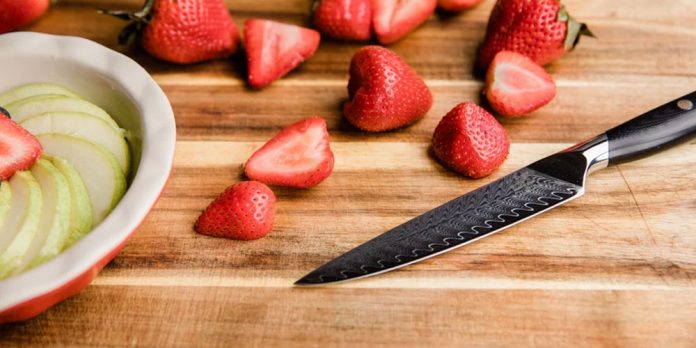You’ve probably noticed the multipurpose knives having hollowed-out protrusions on the blade’s edge. What kind of a knife is it? And why do you need one? What makes a chef’s knife different from a santoku knife? Which is the better option? This is the article to read if you want to learn everything there is to know about Santoku knives and how they compare to chef’s knives.
The imarku santoku knife is made with a comfortable and balanced grip in mind. This knife is popular with the ones having small hands because of the handle design and distribution of the weight.
Santoku Knife
Santoku Knife is a type of Japanese knife. The term “Santoku” means three virtues, or simply the three uses, and it refers to the knife’s ability to chop, dice, and mince. This is an excellent multipurpose knife that can be used for a variety of tasks. It has scallops edges, which provide air between both the blade of the knife and the thing getting cut, allowing the thing to easily remove from the edge. So, if you’re slicing anything thinly, this is the knife to pick.
Which is better: a Santoku or a Chef’s Knife?
Many experienced chefs use both santoku and chef’s knives because they are multifunctional enough to execute a variety of jobs while cooking. Santoku knives are basically a kind of cook’s knife, although they differ from classic German and French-style blades in terms of shape and design.
The Major Difference: Cutting
The contrast between both of them is that santoku knives are probably more suited for precise cutting, where mostly thin and fine cuts are required. With a chef’s knife, achieving comparable precision and accuracy is more difficult. In addition, Santoku knives generally demand a special technique, cutting down the foodstuff in a front and reverse motion rather than a rolling backward and forwards motion as a typical chef’s knife does. Please note that chef’s knives come in a variety of styles.
Some of the other differences are as follows:
Length of the blade
Santoku knives feature a smaller blade as compare to chef’s knives, measuring around 6 inches in length. The smaller blade allows for better handling, which is especially advantageous for inexperienced cooks. A chef’s knife blade is 8 inches and more in length.
Material of the blade
Most of the kitchen knives blades are composed of stainless steel; however, the quality of steel produced varies according to the manufacturer. Western knives feature thick blades and are composed of tougher and softer steel. The steel’s softness implies that the edges need to be sharpened more regularly. Chef’s blades are much less likely to break due to the steel blade’s softness. However, the blade’s toughness might make them appear weighty, which might or might not be a bad or good quality of a knife based on your particular preference.
Handle
A bolster that is a prominent component of a French or German handle is not typically found on Santoku knives. Someone inexperienced in the use of professional blades would benefit tremendously from picking a knife with a bolster because it can assist prevent the user’s hand from dropping down the edge and providing additional grip. Both the knives often have a complete tang, which gives them a balanced touch.
Which knife is the best?
In the end, the knife you select is the one that best fits your hand and cooking technique. A Santoku knife is a wiser alternative if you prepare a specific meal, such as a meal including more fish, fruits, and veggies but low on meat. A chef’s knife is a perfect choice if you need a tough all-arounder that can cut meat, chop tiny bones, and slice fruits and veggies. It’s wise to invest in both kinds of knives if you spend too much time while preparing a variety of delicious foods.











